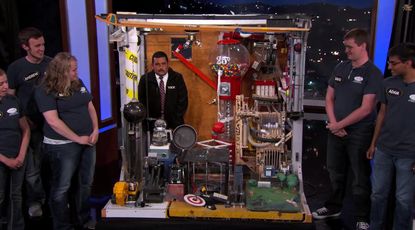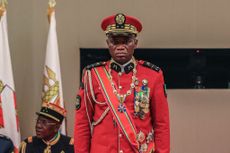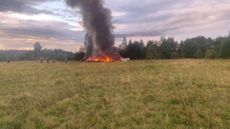Purdue's victorious Rube Goldberg machine is actually kind of terrifying
Kimmel Live


Who doesn't love a good Rube Goldberg machine? Purdue University has been hosting a contest every year since 1983, and nationally since 1989, to see which collegiate team can build the best Goldberg-style contraption, defined as accomplishing a simple task in no fewer than 20 steps. This year, the task was zipping a zipper, and the home team won — Purdue's Rube Goldberg squad managed to contrive about 75 steps to complete the easiest of objectives.
Kudos to Jimmy Kimmel for having the team bring their Rube Goldberg machine on his show. The dumpster-diving engineers who designed and built it are as delightful as you'd expect, and their machine really is quite impressive — though if I were Guillermo, I'd have been pretty nervous near the end, too. There's probably a reason this is the first entry in more than 30 years to incorporate a human participant. --Peter Weber
Subscribe to The Week
Escape your echo chamber. Get the facts behind the news, plus analysis from multiple perspectives.

Sign up for The Week's Free Newsletters
From our morning news briefing to a weekly Good News Newsletter, get the best of The Week delivered directly to your inbox.
From our morning news briefing to a weekly Good News Newsletter, get the best of The Week delivered directly to your inbox.
Create an account with the same email registered to your subscription to unlock access.
Sign up for Today's Best Articles in your inbox
A free daily email with the biggest news stories of the day – and the best features from TheWeek.com
Peter has worked as a news and culture writer and editor at The Week since the site's launch in 2008. He covers politics, world affairs, religion and cultural currents. His journalism career began as a copy editor at a financial newswire and has included editorial positions at The New York Times Magazine, Facts on File, and Oregon State University.
-
 How to find cheaper car insurance as premiums accelerate
How to find cheaper car insurance as premiums accelerateThe Explainer Car insurance costs are rising but there are ways to put the brakes on price rises
By Marc Shoffman, The Week UK Published
-
 What to know when planning an awe-inspiring hike on the Inca Trail
What to know when planning an awe-inspiring hike on the Inca TrailThe Week Recommends Peru's most famous trail leads to Machu Picchu
By Catherine Garcia, The Week US Published
-
 Lead poisoning remains a threat
Lead poisoning remains a threatThe Explainer The toxin is built into our lives
By Devika Rao, The Week US Published
-
 Puffed rice and yoga: inside the collapsed tunnel where Indian workers await rescue
Puffed rice and yoga: inside the collapsed tunnel where Indian workers await rescueSpeed Read Workers trapped in collapsed tunnel are suffering from dysentery and anxiety over their rescue
By Sorcha Bradley, The Week UK Published
-
 More than 2,000 dead following massive earthquake in Morocco
More than 2,000 dead following massive earthquake in MoroccoSpeed Read
By Justin Klawans Published
-
 Mexico's next president will almost certainly be its 1st female president
Mexico's next president will almost certainly be its 1st female presidentSpeed Read
By Peter Weber Published
-
 North Korea's Kim to visit Putin in eastern Russia to discuss arms sales for Ukraine war, U.S. says
North Korea's Kim to visit Putin in eastern Russia to discuss arms sales for Ukraine war, U.S. saysSpeed Read
By Peter Weber Published
-
 Gabon's military leader sworn in following coup in latest African uprising
Gabon's military leader sworn in following coup in latest African uprisingSpeed Read
By Justin Klawans Published
-
 Nobody seems surprised Wagner's Prigozhin died under suspicious circumstances
Nobody seems surprised Wagner's Prigozhin died under suspicious circumstancesSpeed Read
By Peter Weber Published
-
 Western mountain climbers allegedly left Pakistani porter to die on K2
Western mountain climbers allegedly left Pakistani porter to die on K2Speed Read
By Justin Klawans Published
-
 'Circular saw blades' divide controversial Rio Grande buoys installed by Texas governor
'Circular saw blades' divide controversial Rio Grande buoys installed by Texas governorSpeed Read
By Peter Weber Published